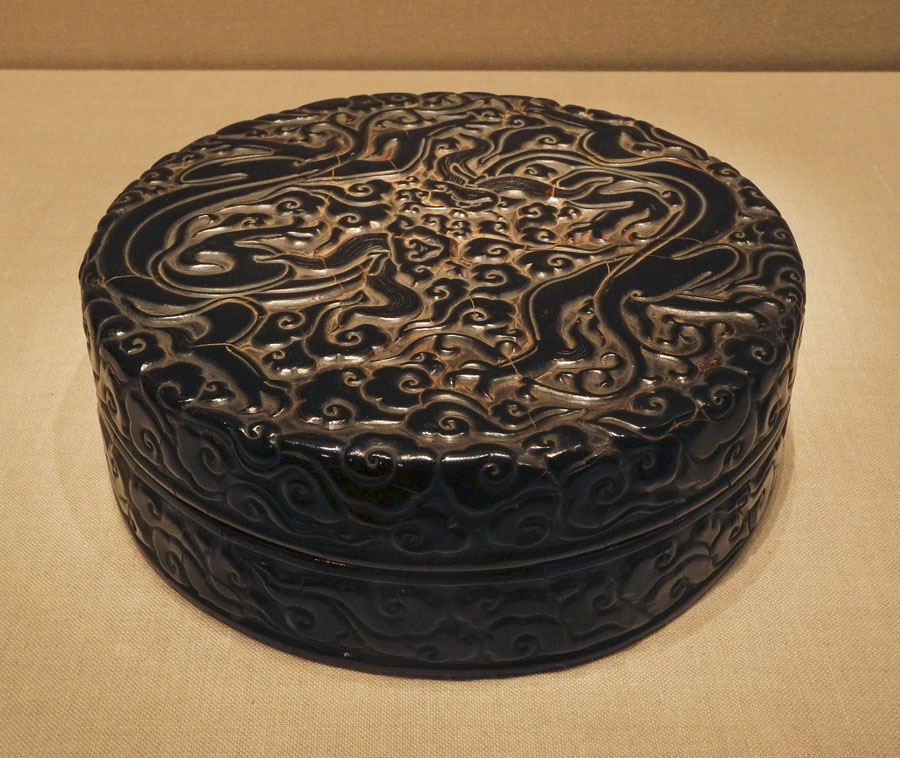Incense Box with Fragrant Grass Design, China, 14th century; carved black, red, and yellow lacquer
Oh, how I love the Metropolitan Museum of Art! I've wandered the galleries there for years, but there is always something new to discover. A couple of years ago I went down a staircase from the Medieval galleries and found the Antonio Ratti Textile Center which was then showing very beautiful European lace. On my most recent trip, walking up a staircase at the end of the Chinese collection, I discovered 4 small galleries––#s 219 - 222––on the 3rd floor, dedicated to Chinese Decorative Arts. My favorite show tucked away up there was Sumptuous: East Asian Lacquer, 14th - 20th Century (though I didn't see anything from the 20th century). You can see all 44 pieces in the show at the link. There is such wonder in fine objects such as these, in their creativity of pattern and image, and in their inventive and complex process.
Box with Pommel Scrolls, China, 1st half 14th century; carved red and black lacquer
These gorgeous patterns are carved into lacquer that was layered on wood. The lacquer comes from the sap of the lacquer tree, which hardens when exposed to oxygen and humidity (this information from a wall label at the show). The red lacquer is colored with cinnabar, the black with carbon.
Box with Dragons Amid Clouds, China, late 13th-early 14th century; carved black, red, and yellow lacquer.
As many as 200 layers of laquer are laid down on the wood surface, though the number is usually around 30; each layer is allowed to dry completely before the next one is added.
Box with Landscape and Scroll Pattern, Japan, Edo period (1615-1868); carved red lacquer.
Carved lacquer began in China; the technique was also used in Japan. The carving allowed for beautiful relief effects, much like "fine art" sculpture. My favorite pieces are the two red dramatically carved Chinese boxes with their overall patterns.
Box with Geometric Designs, China, late 17th century; black lacquer with mother-of-pearl inlay.
Another spectacular technique in lacquerware is using mother-of-pearl inlays. The mother-of-pearl, some of which was tinted on the back to give it some color, sparkles against the rich black of the lacquer. This piece is especially fine, with its tiny patterning; I can hardly imagine the patience and precision that was required to make it.
Box with Peony Scrolls, Korea, 15th-16th century; black lacquer with mother-of-pearl inlay.
A swirlingly lovely pattern of flowers, leaves, and branches.
Incense Box with Chrysanthemums, Japan, second half of 19th century; gold hiramaki-e on mother-of-pearl ground.
I love this little box, made with the maki technique of sprinkling gold powder on lacquer; here there is also a mother-of-pearl inlay. It makes a light-filled object, delicate and poetic.
Writing Box with Plum Blossoms and Moon, Japan, 18th century; reddish-brown lacquer with gold hiramaki-e, lead, and mother-of-pearl inlay.
This, and the next few pieces, use a combination of techniques, used to best express the character of the image. The simplicity of design of this writing box, with its dark circle for a moon and its curved branch of blossoms, reminds me of the Rinpa aesthetic, in which nature is described with sensitivity and is balanced with emptiness.
Writing Box with Poet Kakinomoto Hitomaro, Japan, 17th-18th century; black lacquer with gold and silver takamaki-e, hirmaki-e, cutout gold and silver foil application, and lead rim.
Kakinomoto Hitomaro was the "patriarch of Japanese poetry". Inside the lid of this lovely box is a landscape (which you can see here) that illustrates his poem
Dimly through morning
Mists over Akashi Bay my
Longings trace the ships
As they vanish beyond
the island.
Stationery Box with Moon and Autumn Grasses, Japan, 18th century; black lacquer with powdered and sprinkled gold and silver hiramaki-e and silver foil application.
The delicacy of the imagery on this box is full of longing and memory.
Box with Crabs and Waves, Japan, 17th century; black lacquer with gold maki-e.
A much bolder design displays a different sensibility, but each, the grasses and the crabs, are assuredly elegant and ask for quiet and prolonged looking. Wouldn't it be wonderful to be able to be intimate with any of these works?
School of Shibata Zenshin (1807-1891), Writing Box with Gourd, Japan, 1886; black lacquer with gold and silver hiramaki-e, colored lacquer application.












Your post is the supreme holiday gift. Thanks for these luscious images.
ReplyDeleteI'm so glad you enjoyed the post, Patricia.
Deletenice post.. nice artistic thanks
ReplyDelete